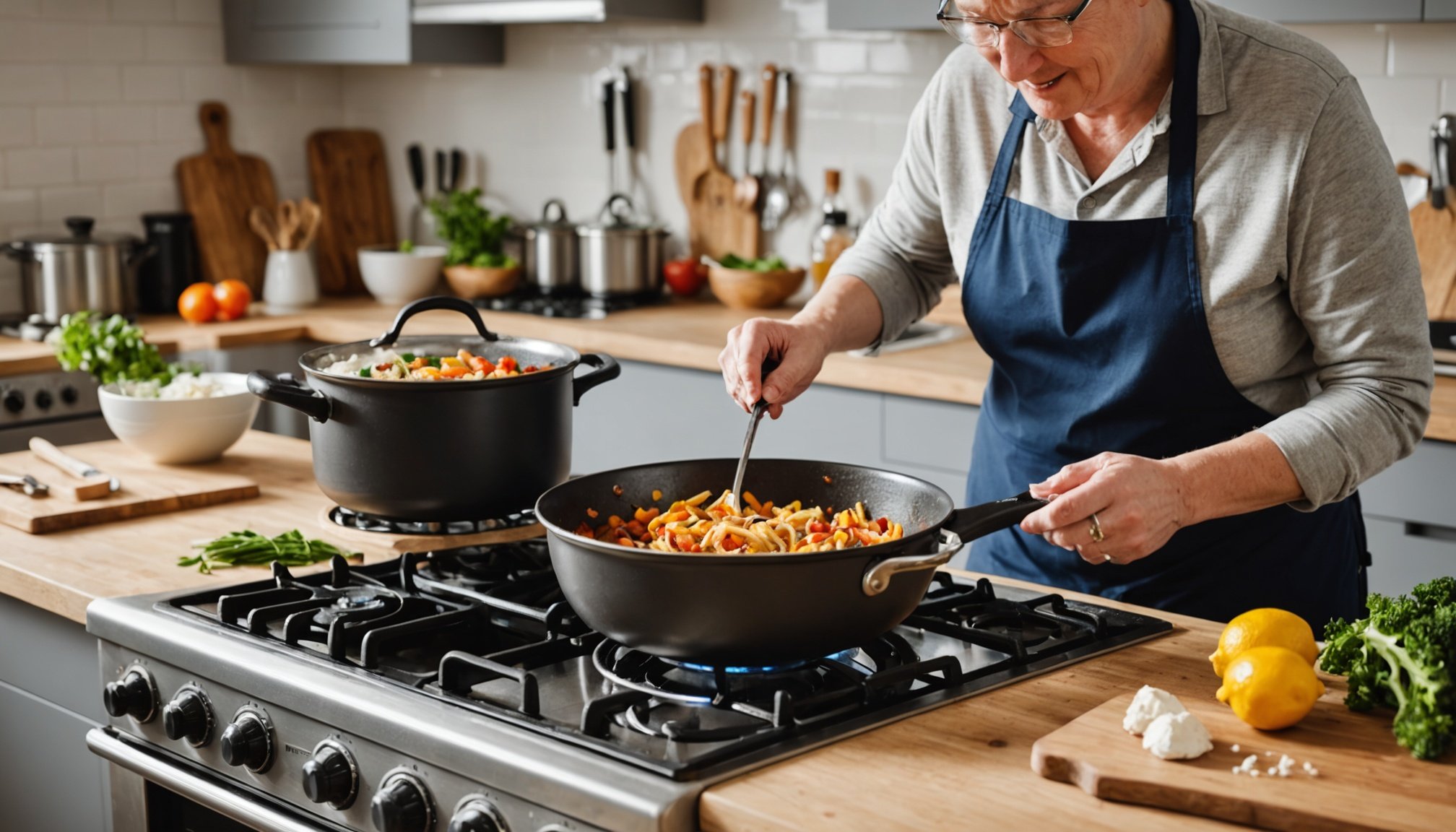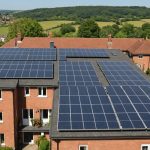Overview of Energy-Saving Cooking Techniques
Cooking can be fun, but it should also be energy-efficient. Embracing energy-saving cooking methods is key to not only reducing your carbon footprint but also lightening your utility bills. In the UK, where home energy costs are a substantial part of household expenses, adopting these methods is a smart move.
The journey toward energy efficiency in cooking starts with a few simple habits. For instance, always use pots and pans that match the size of the stove’s burner to ensure even heat distribution. This small adjustment ensures that no energy is wasted and cooking times are reduced.
A lire en complément : Exploring Optimal Approaches for Retrofitting Double Glazing in York’s Historic Listed Buildings
Moreover, using lids when boiling or simmering significantly cuts down the cooking time and thus, energy consumption. Similarly, investing in a slow cooker or pressure cooker paves the way for energy-saving cooking methods. These appliances are designed to use less electricity than traditional ovens, making them an efficient alternative.
In the broader picture, energy-efficient cooking techniques stem from understanding the unique requirements of your kitchen appliances. Regular maintenance, such as cleaning your oven and replacing worn-out seals, can make a noticeable difference in energy consumption, keeping your utility bills in check.
Dans le meme genre : Maximizing Solar Efficiency: The Best Panel Arrangement for Terraced Roofs in Reading
Batch Cooking
Exploring the batch cooking methods can revolutionise how you manage meals while simultaneously saving time and money. This technique involves preparing meals or components of meals in bulk. Once cooked, meals can be portioned and stored for convenient consumption throughout the week. Opt for recipes that freeze well, ensuring you can enjoy them without sacrificing flavour or texture.
Benefits of Batch Cooking
Batch cooking offers significant cost savings, as buying ingredients in bulk is often cheaper. By planning wisely, you can also minimise food waste. Furthermore, batch cooking transforms meal prep into a swift process, freeing up precious time during hectic weekdays.
How to Get Started with Batch Cooking
To embark on your batch cooking journey, begin by selecting a few versatile recipes. Plan your meals for the week, make a detailed shopping list, and devote a few hours over the weekend to cook. Investing in quality containers for storage will pay off handsomely.
Tips for Storing and Reheating Properly
Storing your meals efficiently is key to maintaining food quality. Consider these storage solutions:
- Use stackable containers for best use of space.
- Label meals with cooking dates to track freshness.
When reheating, ensure food reaches a safe temperature to preserve both taste and safety.
Slow Cookers and Pressure Cookers
Cooking appliances have evolved to not only make culinary tasks easier but also to enhance energy efficiency. Slow cookers and pressure cookers are kitchen mainstays that offer modern solutions, reducing both cost and environmental impact.
Energy Efficiency of Slow Cookers
Slow cookers are lauded for their energy efficiency, utilising lower wattage over extended hours, translating to lower energy bills. Compared to traditional ovens which consume significantly more electricity, slow cookers use minimal resources, aligning perfectly with energy-conscious households in the UK.
Comparing Slow Cookers to Traditional Cooking Methods
When stacked against traditional cooking methods, slow cookers present a significant advantage. Conventional methods can be energy-hungry, especially when used over long periods for stews or roasts. However, slow cookers provide the same hearty results with a fraction of the energy consumption, making them an eco-friendlier choice.
Recipes Ideal for Slow Cooking
To maximise the energy efficiency of your cooking, consider recipes specifically designed for slow cooking. Dishes like casseroles, soups, and pulled meats thrive in the slow cook environment. These recipes not only utilise less energy but also enhance flavours through the prolonged cooking process, an added benefit on top of the energy savings. By carefully selecting meals that require extended cooking times, one can harness the full efficiency potential of this ingenious appliance.
Proper Oven Usage
For anyone determined to improve oven efficiency, understanding the nuances of usage is crucial. Whether it’s stacking items correctly, utilising the right temperature, or selecting the ideal oven model, each decision impacts performance.
Stacking and Arranging Food in the Oven
Properly stacking and arranging food not only optimises cooking but also boosts energy efficiency. Avoid overcrowding as air must circulate around dishes for even cooking. For those with multiple racks, alternating pans allows heat to flow freely. This strategic placement ensures effective heat distribution, enhancing overall oven efficiency.
Using the Right Temperature Settings
Incorrect temperature settings can increase energy consumption significantly. Cooking at higher temperatures doesn’t necessarily mean faster or better results. Matching the required temperature with the right recipe can make all the difference in oven efficiency, resulting in even cooking and reducing unnecessary energy waste.
Benefits of Convection Ovens
Convection ovens are a game-changer for energy-conscious cooks. They circulate hot air using fans, providing uniform temperature distribution and often reducing cooking times. When comparing conventional with convection ovens, the latter often proves superior in both cooking speed and energy efficiency. This offers a practical solution for those keen on conserving energy without compromising on quality outcomes.
Utilizing Energy-Efficient Appliances
Adopting energy-efficient appliances in your home not only reduces household energy consumption but also contributes to environmental sustainability. When integrated thoughtfully, these appliances can offer cost savings and improved performance.
Choosing the Right Appliances for Your Kitchen
Selecting the right energy-efficient appliances for your kitchen begins with understanding the energy needs of your home. Look for appliances with high energy ratings, which are indicative of their efficiency compared to standard models. Prioritise appliances that support energy conservation, such as induction cooktops and energy-star-certified refrigerators and dishwashers. These appliances typically utilise advanced technologies that reduce energy usage while enhancing functionality.
Energy Ratings and Their Significance
Energy ratings are a crucial factor when deciding on energy-efficient appliances. In the UK, appliances are rated from A+++ (most efficient) to D (least efficient). Understanding these energy rating systems helps in identifying appliances that deliver optimal energy performance. Higher-rated models may have a higher initial cost, but their lower operating expenses can lead to long-term savings.
Maintenance Tips for Longevity and Efficiency
To maintain the energy-efficiency of your appliances over time, regular maintenance is essential. Clean refrigerator coils routinely and ensure that seals remain intact to prevent energy loss. Similarly, descaling kettles and dishwashers promotes efficient heating. By following these insights, you can ensure your appliances operate at peak performance.
Alternative Cooking Methods
Exploring alternative energy cooking methods not only saves electricity but also optimizes your kitchen’s efficiency. Let’s delve into these modern techniques and their practicality.
Microwaves and Their Efficiency
Microwaves offer an efficient method for daily cooking, utilizing less energy than traditional ovens by directly targeting the moisture in food. This approach results in quicker heating times, reducing overall energy consumption. When comparing cooking times and energy usage, microwaves stand out, as they often accomplish tasks in a fraction of the time required by conventional means.
Induction Cooktops as a Modern Solution
Induction cooktops represent a leap in technology, boasting increased safety and efficiency. They employ electromagnetic fields to directly heat your cookware, resulting in minimal energy waste. This process contrasts with gas stoves, where energy is lost as ambient heat. Induction cooking is not only faster but also more precise, allowing for consistent culinary results.
Benefits of Outdoor Cooking
Outdoor cooking introduces a social and energy-efficient aspect to meal preparation. Using outdoor cooking appliances, such as grills or solar ovens, harnesses natural resources and often reduces reliance on electricity. This method also promotes larger batch cooking, often more efficient than smaller, repeated indoor sessions, making it a versatile solution for energy-conscious individuals.
Tips for Reducing Energy Consumption
Reducing energy consumption in the kitchen is not only beneficial for your wallet but also for the environment. By implementing energy conservation tips, you can make a significant impact with minimal effort.
Mindful Cooking Practices
Adopting mindful cooking practices can lead to noticeable energy savings. Use the correct pot size for your burner to reduce heat loss and optimise energy use. Using lids on pots is another simple but effective way to conserve energy, as it traps heat and cook meals faster.
Organizing Cooking Sessions
Consider meal planning to streamline cooking sessions. By preparing ingredients in advance and cooking multiple meals at once, you can lower energy usage. Additionally, batch cooking can significantly reduce the energy consumed by ovens and stoves since you won’t be using them multiple times for separate meals.
Importance of Cleanliness in Appliances
Maintaining clean appliances is crucial for energy efficiency. For example, a clean oven heats more effectively, consuming less energy. Regularly checking and cleaning refrigerator coils can also improve its performance, thus reducing energy consumption. By reducing passive energy waste, you maintain your appliances’ optimal efficiency while enjoying the convenience of a clean kitchen environment.
By leveraging these practical tips, you can enjoy both cost savings and an overall reduction in energy use.











